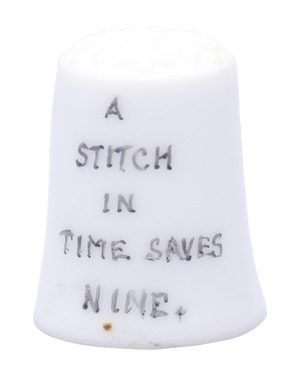

From the collection of Marianne Kerr. Gift from New Zealand from Barbara Berry, November 1985.
Much of our everyday language—in the form of idioms, clichés, or metaphors—makes reference to textiles. Using these phrases, we weave stories, spin tales, and thread narratives. But where do these expressions come from, and what do they mean?
In a blog series posted on intermittent Mondays, we unpack textile-related idioms. Stay tuned to learn their metaphorical and historical meanings.

“A stitch in time (saves nine)” is a somewhat archaic phrase that refers to the importance of solving problems preemptively, rather than later down the line. The idiom has been in use in English since before the eighteenth century and was first recorded in Thomas Fuller’s 1732 book, Gnomologia: A Collection of the Proverbs, Maxims and Adages That Inspired Benjamin Franklin and Poor Richard’s Almanack.
The saying asserts that it is better to repair a rip or tear in a piece of fabric when it first forms—with one stitch—rather than wait until it has grown larger and requires nine stitches. It is often shortened to “a stitch in time,” thus prioritizing the initial solution.
